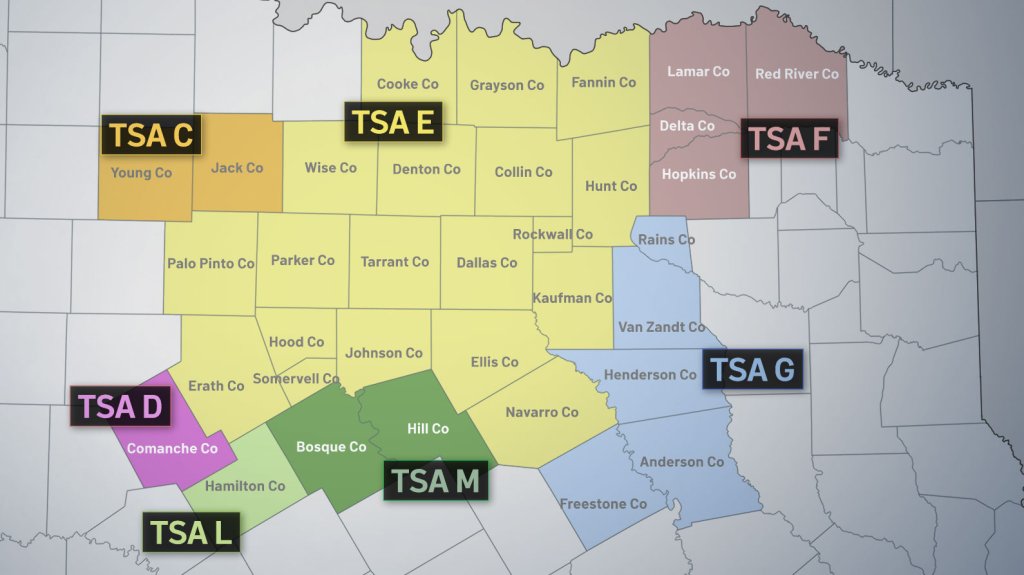Patients Hospitalized With COVID at Levels Not Seen Since January – NBC 5 Dallas-Fort Worth
The percentage of patients hospitalized with COVID-19 in almost every hospital area in North Texas has exceeded the markers set by Governor Greg Abbott last year, which data from the Texas Department of State Health Services said would have triggered safety measures.
Abbott’s executive order, issued last October, which uses hospital admissions percentage as a barometer, is no longer in force.
Of the seven hospital regions with counties within sight of NBC 5, only one – Trauma Service Area C – does not meet the brand. TSA C, which is northwest of Dallas-Fort Worth, includes the counties of Jack and Young.
If the percentage of patients admitted to hospital with COVID-19 in a trauma service area exceeded 15% for seven or more consecutive days, Abbott’s October 2020 order required all non-essential businesses to cease utilization immediately Reduce 75% to 50%. Bars in these TSAs had to close and licensed hospitals had to stop elective surgery.
Dallas-Fort Worth Hospital Council President and CEO W. Stephen Love said health professionals “do not advocate on-site accommodation” but “wearing masks in public is not asking too much.”
These were once thought of as the containment strategies needed to contain the spread of disease in Texas, and that was before the virus evolved into the more highly communicable and heavier Delta variant.
Non-essential businesses, according to the regulation, included restaurants, retail stores, office buildings, manufacturing facilities, gyms and exercise facilities, museums and libraries, while bars were defined as businesses whose sales were 51% or more from alcohol.
The Dallas-Fort Worth area is located in Trauma Service Area E, which includes 19 counties: Collin, Cooke, Dallas, Denton, Ellis, Erath, Fannin, Grayson, Hood, Hunt, Johnson, Kaufman, Navarro, Palo Pinto, Parker, Rockwall, Somervell, Tarrant and Wise.
Patients with COVID-19 have occupied more than 15% of TSA E hospital beds since at least August 9 23.
Despite rising COVID-19 cases, hospitalizations, and deaths, Abbott has issued an executive order banning public entities, including counties, cities, school districts, and public universities, from requesting masks. He also prevented district officials from taking action to restrict traffic in local businesses.
“The way forward depends on personal responsibility, not government mandates,” Abbott said last month. “The state of Texas will continue to vigorously combat the injunction to protect the rights and freedoms of all Texans.”
Abbott’s office did not respond to a request for comment on Monday.
Love said it was hard to compare that surge to previous rises in falls.
“The Delta variant is a game changer, so comparing this fourth climb to previous climbs is not a valid comparison,” Love said via email. “All unvaccinated people play Russian roulette with the Delta variant. Yes, the Delta variant can infect vaccinated people, but they are rarely hospitalized and generally have a very mild case.”
He cited a number of events like college football games, meetings and conferences that meet in person this year that do not require masks for people who are vaccinated as “big mistakes”.
“Things are not back to normal and I can take you to our COVID-19 units to show you young people dying from the Delta variant. Absolutely, nowhere near normal or pre-pandemic activities, ”wrote Love. “It will be interesting to see how Labor Day behavior affects the spread of the community and we are fast approaching flu season. Last year people wore masks that helped stop the flu virus from spreading, but this year we could see a twin pandemic that would completely overwhelm our hospitals. “
Texas ranks 29th in the country according to data from the Centers for Disease Control and Prevention, with 57.8% of the eligible population fully vaccinated against COVID-19.
NBC 5 news
TSA regions in North Texas
The Texas Trauma Service Areas are 22 regional facilities that comprise the 254 counties of Texas. Each TSA is administered by a regional advisory board that is “tasked with developing, implementing and monitoring a regional trauma system plan for the emergency medical service”. RACs are made up of healthcare institutions and citizens and are not all structured alike, but they all have the same goals: “To reduce the incidence of trauma through education, data collection, data analysis and performance enhancement”.
[ad_1]


